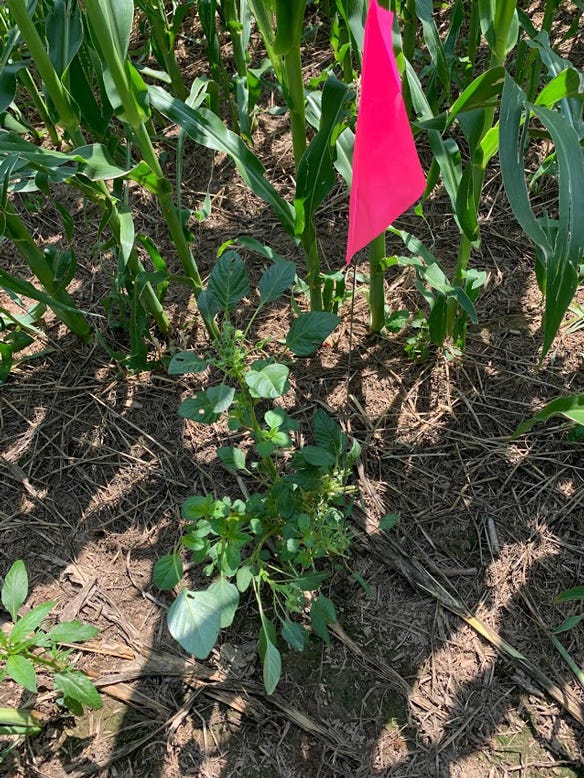July 19, 2021

The invasive weed Palmer amaranth was positively identified in Goodhue County for the first time, Minnesota Department of Agriculture officials recently announced.
After a crop consultant reported a suspected plant to the MDA, staff conducted a site visit and found the weed in two cornfields managed by one farmer. MDA staff scouted fields surrounding the documented infestations and did not find any additional Palmer plants.
It is unknown at this time how Palmer amaranth got into the two fields. MDA continues to investigate potential sources.

GOODHUE SITE: This Palmer amaranth plant was found in a Goodhue County cornfield by a crop consultant, according to the Minnesota Department of Agriculture. A herbicide application stunted the plant but did not kill it.

A herbicide application stunted, but did not kill, the plants. A crew hand-pulled weeds in the two fields to eliminate any chance of seed production. MDA will continue to work with the farmer, crop consultants, University of Minnesota Extension and the county agricultural inspector to manage these infestations.
“This is a good example of the limits of herbicide on Palmer amaranth,” says Denise Thiede, MDA’s seed unit supervisor. “If plants are allowed to reach a certain size, a herbicide application may not control them. That’s why we’re counting on farmers and crop consultants to report suspected plants. They are our best line of defense against Palmer amaranth.”
Reporting process
If you or your crop consultant suspect the presence of Palmer amaranth, MDA and University of Minnesota Extension suggest:
• Take pictures of the plant(s) in question before pulling them. Pictures should include clear visibility of the whole plant, a close-up of the leaf and where it attaches to the stem, the flower head, and a leaf with the petiole folded over.
• Save plants in a refrigerated plastic bag for any genetic testing that may be needed.
• Report the find to MDA’s Arrest the Pest line at 888-545-6684 or [email protected]. U-M Extension educators are available to assist in this process as well.
Extension staff notes that the key to successfully eradicating Palmer amaranth in Minnesota is early detection and reporting. Remember, you are not in trouble for having Palmer amaranth in your field, especially considering the numerous routes of entry. Plus, reporting means that you are not on your own when it comes to managing Palmer amaranth infestations.
Weed ID
As weed escapes become more obvious in row crops, now is the time to be scouting for Palmer amaranth. Being observant now can prevent big headaches later on. Palmer amaranth can be identified by the following characteristics:
• The green leaves are smooth and arranged in an alternate pattern that grows symmetrically around the stem. The leaves are oval to diamond or triangle shaped.
• The leaves of some Palmer amaranth plants have a whitish, V-shaped mark on them. Not all Palmer amaranth plants display this characteristic.
• Palmer amaranth looks similar to our native pigweeds such as waterhemp (A. tuberculatus and A. rudis), Powell's amaranth (A. powellii), and redroot and smooth pigweeds (A. retroflexus and A. hybridus, respectively). Here are some distinguishing characteristics: Redroot and smooth pigweeds have fine hairs on their stems and leaves. Palmer amaranth and waterhemp do not have these hairs. The petiole (stalk connecting a leaf to the stem) is longer than the length of the leaf. For waterhemp, the petiole will be only half the length of the leaf. Seed-head spikes on female Palmer amaranth plants are much taller (up to 3 feet long) and pricklier than waterhemp or redroot and smooth pigweed spikes.
Photos and other information on Palmer amaranth can be found on the MDA website at mda.state.mn.us/palmeramaranth.
Palmer amaranth is listed as a noxious weed in Minnesota and was first discovered in the state in 2016. All above- and belowground parts of the plant must be destroyed, and it cannot be moved. The invasive weed is also listed as a prohibited weed seed in the state. This means no Palmer amaranth is allowed in any seed offered for sale in Minnesota.
Palmer amaranth has been found in 11 Minnesota counties, including Goodhue County. However, most of the sites have been successfully eradicated, and the remaining ones are being closely monitored. Details of previous finds can be found on the MDA website.
Left uncontrolled, a single female Palmer amaranth plant typically produces 100,000 to 500,000 seeds. It is resistant to multiple herbicides, can cause substantial yield losses, and greatly increase weed management costs in soybeans and corn.
Source: Minnesota Department of Agriculture and University of Minnesota Extension, which are solely responsible for the information provided and is wholly owned by the source. Informa Business Media and all of its subsidiaries are not responsible for any of the content contained in this information asset.
You May Also Like




